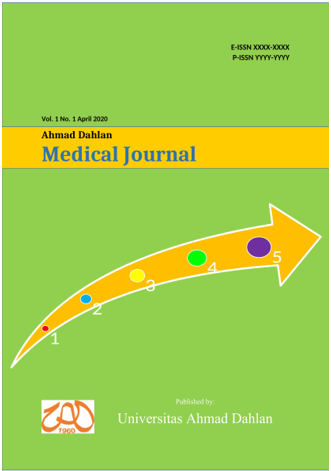The Complication of Tinea Pedis to Onychomycosis On Disposal Officer
Abstract
Superficial dermatomycosis is the most common type of infection, which affects 20-25% of the world's population. Tinea pedis can cause onychomycosis and has been associated with onychomycosis in 30 to 50% of cases. The study aimed to determine the relationship between Tinea pedis and the occurrence of onychomycosis in scavengers. The research design used in this study is cross-sectional. The sample used was scavengers at the Sukawinatan landfill in Palembang. The sampling method used a consecutive sampling technique for as many as 70 respondents. This study used data obtained from interviews and examination of skin scrapings under a microscope and fungal culture. The results obtained were 31 respondents (44.3%) with tinea pedis and 39 respondents (55.7%) who did not have tinea pedis. Fifty-five respondents (78.5%) had onychomycosis, while 15 (21%) did not. Tinea pedis and onychomycosis are strongly related. The Odds Ratio (95%=CI) of the Chi-Square test was 0.309. Tinea pedis is 0.309 times more likely to have onychomycosis. In conclusion, there was a significant relationship between tinea pedis and the occurrence of onychomycosis in the disposal officer. The emergence of tinea pedis is due to the daily life of scavengers who live side by side with garbage and the lack of concern for personal hygiene which is not optimal, can be prevented and treated.
References
Havlickova B, Czaika VA, Friedrich M. Epidemiological trends in skin mycoses worldwide.
Mycoses. 2008;51(4):2-15. doi:10.1111/j.1439-0507.2008.01668.x
Ilkit M, Durdu M. Tinea pedis: the etiology and global epidemiology of a common fungal
infection. Crit Rev Microbiol. 2015;41(3):374-388.
Noble SL, Forbes RC, Stamm PL. Diagnosis and management of common tinea infections.
Am Fam Physician. 1998;58(1):163.
Noviadi P, Yolanda Siregar T, Shalila May Pratiwi W, Listrianah L. Skin Health Disorders on
Scavengers and Their Causative Factors At Sukawinatan Landfill of Palembang City. J
Kesehat Poltekkes Palembang. 2021;16(2):111-118. doi:10.36086/jpp.v16i1.489
Sahoo A, Mahajan R. Management of tinea corporis, tinea cruris, and tinea pedis: A
comprehensive review. Indian Dermatol Online J. 2016;7(2):77. doi:10.4103/2229-
178099
Leung AKC, Lam JM, Leong KF, Hon KL. Tinea corporis: an updated review. Drugs Context.
;9.
Artha D, Oktasaputri L. Identifikasi Jamur Dermatofita Pada Infeksi Tinea Unguium Kuku
Kaki Petugas Kebersihan Di Daerah Sekitar Jalan Abd.Kadir Kota Makassar. J Media
Laboran. 2020;10:43-47.
Sigurgeirsson B, Steingrimsson O. Risk factors associated with onychomycosis. J Eur Acad
Dermatology Venereol. 2004;18(1):48-51.
Sitepu EH, Muis K, Putra IB. Dermatophytes and bacterial superinfections in tinea pedis
patients at Haji Adam Malik Central Hospital, Medan-Indonesia. Bali Med J. 2018;7(2):452-
Anwar AND. Manfaat Daun Ketepeng Cina (Cassia alata L.) sebagai Antifungi pada Tinea
Pedis Benefits Ketepeng Cina ( Cassia alata L .) as an Antifungal on Tinea Pedis. J
Agromedicine Unila. 2015;2(4):385-388.
Sari IK, Azrin M, Suyanto S. Gambaran Pengetahuan Pemulung Terhadap Aspek Kesehatan
Keselamatan Kerja (K3) Dalam Pengelolaan Sampah Di Tempat Pembuangan Sementara
(TPS) Kota Pekanbaru. Jom. 2016;3(1):1-10.
Downloads
Published
How to Cite
Issue
Section
License
Copyright (c) 2023 Ahmad Ghiffari, Mitayani Purwoko, Reza Reza, Dewi Yuniasih, Lucille Anisa Suardin

This work is licensed under a Creative Commons Attribution-ShareAlike 4.0 International License.
License and Copyright Agreement
In submitting the manuscript to the journal, the authors certify that:
- They are authorized by their co-authors to enter into these arrangements.
- The work described has not been formally published before, except in the form of an abstract or as part of a published lecture, review, thesis, or overlay journal. Please also carefully read Ahmad Dahlan Medical Journal posting Your Article Policy.
- That it is not under consideration for publication elsewhere.
- That its publication has been approved by all the author(s) and by the responsible authorities - tacitly or explicitly - of the institutes where the work has been carried out.
- They secure the right to reproduce any material that has already been published or copyrighted elsewhere.
- They agree to the following license and copyright agreement.
Copyright
Authors who publish with Ahmad Dahlan Medical Journal agree to the following terms:
- Authors retain copyright and grant the journal right of first publication with the work simultaneously licensed under a Creative Commons Attribution License (CC BY-SA 4.0) that allows others to share the work with an acknowledgment of the work's authorship and initial publication in this journal.
- Authors are able to enter into separate, additional contractual arrangements for the non-exclusive distribution of the journal's published version of the work (e.g., post it to an institutional repository or publish it in a book), with an acknowledgment of its initial publication in this journal.
- Authors are permitted and encouraged to post their work online (e.g., in institutional repositories or on their website) prior to and during the submission process, as it can lead to productive exchanges, as well as earlier and greater citation of published work.


